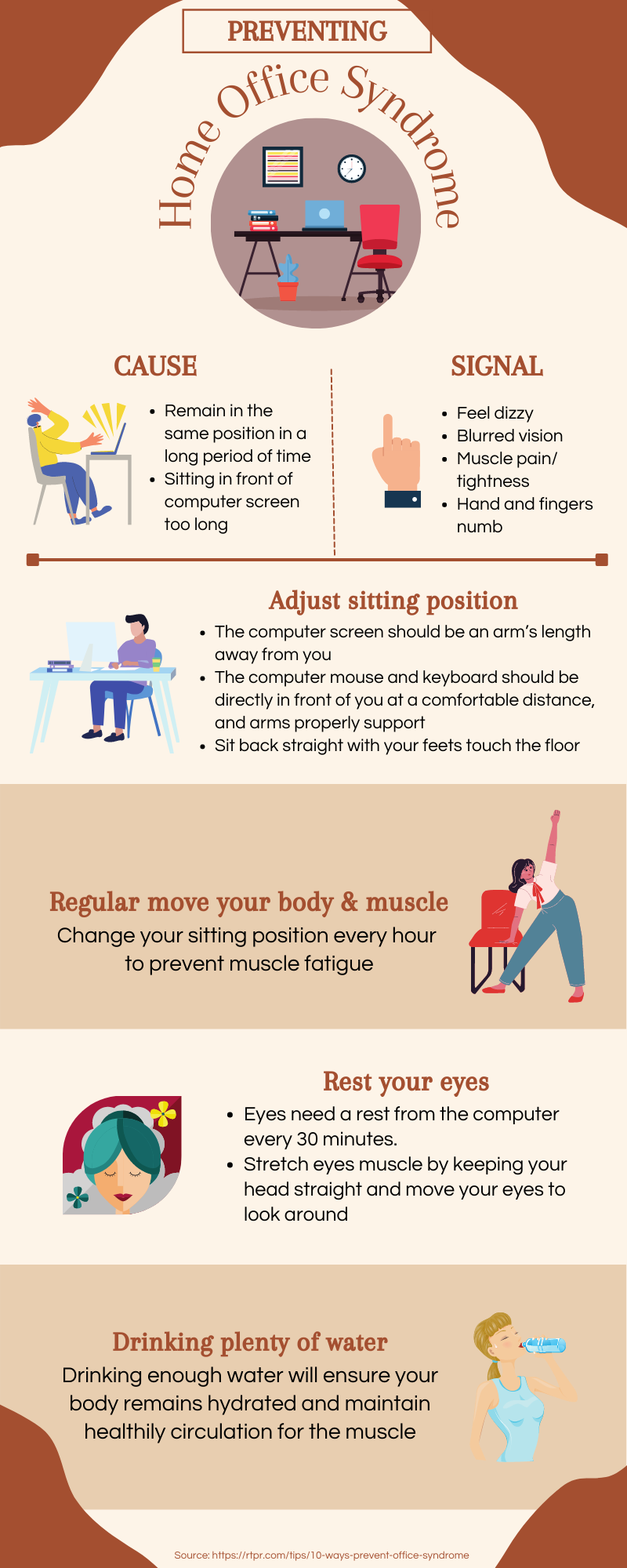Preventing Office Syndrome while working from home
05 March 2021
Post by Admin

With increasing numbers of employees working at home, physical inactivity and prolonged sitting in the same position can lead to an increased risk of developing Office Syndrome.
Office Syndrome has been frequently found in office workers. It is not a disease, instead, Office Syndrome is a group of symptoms caused by sitting or remaining in the same position for long periods of time, mainly while working with the computer in an office setting. Over time, certain muscles become contracted, causing repetitive muscle strain. The main symptom related to the unhealthy sitting posture is muscle pain or tightness, especially in the neck, shoulders and back. Due to the restrictions in movement and activities during lockdowns, people have been currently instructed to work from home. Working at the office allows people to move, walk or change their positions during the day whereas working from home largely limits movement and activities.
A wide variety of conditions of Office Syndrome may include:
- Myofascial pain syndrome: Myofascial pain syndrome refers to chronic pain disorder. In this condition, pressure on sensitive points in the muscles (trigger points) causes pain and compression in the affected muscle e.g. the neck, shoulders and shoulder blades.
- Carpal tunnel syndrome: Carpal tunnel syndrome causes pain, numbness and tingling in the hand, wrist and arm. This condition occurs when the median nerve, one of the major nerves to the hand is squeezed or compressed as it travels through the wrist.
- Trigger finger: Trigger finger causes pain, stiffness and a sensation of locking or catching when bending and straightening finger. The most often affected fingers are ring finger and thumb finger, but it can also occur in the other fingers.
Prevention of Office Syndrome while working from home
- Ergonomics and friendly working environment: The computer mouse and keyboard should be directly in front of you at a comfortable distance, with your arms properly supported. The computer screen should be an arm’s length away from you and level with or slightly below your line of sight. Appropriate lighting can reduce eye fatigue and headaches.
- Regular move your body and muscle: Sitting position should be changed every 1-2 hours in order to prevent muscle fatigue and subsequent slouching. You can also change the angle of your seat and avoid sitting at the edge of the seat.
- Adjusting your sitting position regularly. Proper posture should be maintained by sitting up straight with your shoulders rolled back, your chin tucked to elongate your spine and your thighs are parallel to the floor. Knee flexion should not exceed 90 degrees. If the feet cannot reach the floor, foot support can be used.
- Rest your eyes. Your eyes need a rest from the computer every 30 minutes or so. You can close your eyes for a minute to rest them, or just focus on something other than a glowing computer screen to give them a break. You can also stretch your eye muscles by keeping your head straight and moving your eyes to look around.
- Regular exercise: To reduce repetitive muscle strain, it is important to have regular exercise. Exercises that can stretch and strengthen core muscle groups as well as improve posture are preferred.
- Drink plenty of water. Drinking enough water throughout the day will ensure that your body remains hydrated and maintains healthy circulation for your muscles.

Source: https://www.bangkokhospital.com/en/content/work-from-home-and-office-syndrome
https://rtpr.com/tips/10-ways-prevent-office-syndrome
Business photo created by freepik - www.freepik.com
